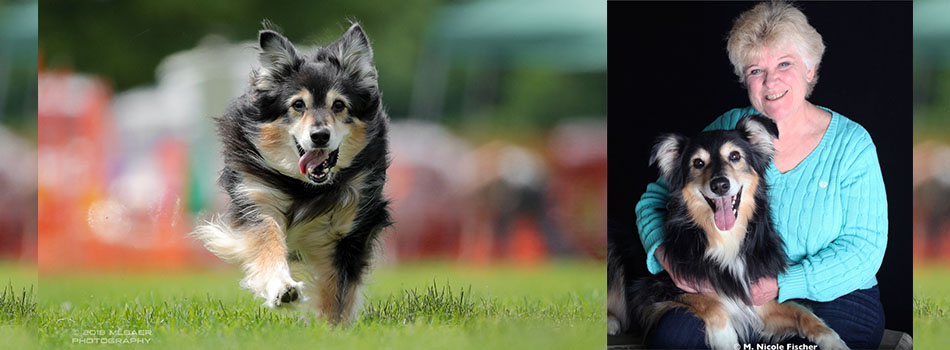Bear was so much more than his rib osteosarcoma diagnosis – he was also a competitive athlete, lover of belly rubs and loyal companion. His story of early detection and treatment demonstrates how critical it is to catch rib tumors in dogs early and how far canine cancer treatment has come over the years. What else can we learn from his inspiring story? Let’s start by understanding rib osteosarcoma.
About Canine Rib Osteosarcoma
Rib osteosarcoma in dogs is rare; however, when it does occur, it has a very high metastasizing rate. Up to 45% of all dogs diagnosed with rib osteosarcoma will have metastasized by the time the vets catch it. Osteosarcoma is a type of bone cancer that develops on the bone. As the bone is comprised of several kinds of tissue that can all be cancerous, vets have to be extremely cautious during diagnosis.
That said, osteosarcoma is more prevalent in larger breeds such as Springer Spaniels, Shar Peis, Giant Schnauzers, Rottweilers, Giant Pyrenees, Irish Setters, Rough Coated Collies, German Short-haired Pointers, British Bulldogs, Australian Shepherds, Dobermans, Bassett Hounds, Labrador Retrievers, and Golden Retrievers. Dogs with osteosarcoma are usually very young (around 2-4yrs) or approaching old age (7-9yrs).
As in Bear’s case, the doctor may recommend a needle biopsy as the first step towards diagnosis. However, they will likely follow this up with CT scans as they are clearer and allow the doctor to determine the tumor’s location for surgical planning.
What Are The Signs and Symptoms of Rib Osteosarcoma in a Dog?
The most obvious sign of a possible tumor is a palpable lump on your dog’s chest. However, your dog may exhibit symptoms before a lump is noticeable. If you notice any of these symptoms, take your dog to your veterinarian for examination:
- Lumps on the dog’s rib cage
- Difficulty breathing (due to the tumor pressing on the lung)
- Lethargy
- Lameness in forelimbs (most common if the tumor is on the first four ribs)
For Bear, his mom noticed a small lump on his chest as he was being groomed and reached out to the vet right away for an opinion.
What Treatment Will My Vet Recommend for Rib Tumors?
 Before surgery, your vet will need to carry out a series of tests to determine how healthy your dog is and if they are strong enough to go through surgery. These tests include preoperative blood work, urine tests, and chemistry profiles.
Before surgery, your vet will need to carry out a series of tests to determine how healthy your dog is and if they are strong enough to go through surgery. These tests include preoperative blood work, urine tests, and chemistry profiles.
Once you have the green light, you can proceed with surgery. The dog will need to be kept off food and given a dose of Pepcid AC prior to surgery. Your dog will be prescribed pain medication for use during and after surgery. These include general anesthesia, analgesics, and anti-inflammatory medicines.
Though cancer can sometimes feel like a death sentence, there are dogs that pull through and go on to live happy and healthy lives – just like Bear. Even though rib osteosarcoma in dogs is very aggressive and the statistics are grim, Bear is a shining example of how a dog can not only survive rib osteosarcoma but thrive beyond all expectations. Read his story below, as told by his owner and our dear friend, Deb Salerno.
Bear’s Cancer Survivor Story
In 2015 Bear and I were on our way to qualifying for the agility Nationals. One night while grooming him, I felt a lump on his left side. The next day I called my veterinarian who had me bring him right in. After a needle aspiration showed suspicious cells, my vet conducted a biopsy and came back with a diagnosis every dog owner dreads. The results confirmed that Bear had osteosarcoma of the rib, one of the most aggressive cancers in dogs.
Right away, my vet made an appointment with the oncologist and surgeon. Bear went through surgery two days later; he had 2 ribs removed with clean margins. They gave us the prognosis of a couple of months, “if we were lucky”. We then went through six rounds of chemotherapy before getting introduced to an Integrated Oncologist. She gave me hope that Bear would live longer and was our partner in our fight against cancer for 5 1/2 years. She treated him with diet recommendations, supplements, and acupuncture. Additionally, she treated Bear like a king, which was very exciting for him. He loved all the attention and didn’t make a fuss about the needles at all. However, there was still something missing. After all, Bear was an athlete.
When we were certain the worst was behind us, Bear decided he wanted to run in agility again. Of course, I agreed! He joined the “I’m Not Dead Tour” with his friend Ethan and performed very well. Though he finally retired from agility at Westminster’s Master’s Championship in 2018, his athletic endeavors were far from over. He switched sports to CAT and Fast CAT. He even wanted to try dock diving but I wouldn’t let him (my protective instinct kicked in). I did let him swim in his lake as a compromise.
In December 2020 at 15 years old, Bear crossed the Rainbow Bridge on his terms. I continue to cherish the lessons he taught me: to live life to the fullest, follow your heart, and always have a smile on your face. He did.
Vets, specialists, and friends all mean well, but in my experience, you don’t have to blindly listen to their opinions. No one knows your pet the way you do. Whatever path you choose, is the right path. Take comfort in that.
Other Articles of Interest:



I love this story and would love to have the same outcome for my boy Sky he was diagnosed with osteosarcoma of the rib with shadows on the lungs. He is only 2 years old and was diagnosed two days after his birthday. I am told the surgeon doesn’t feel surgery will work because of the size of the tumor and the lung masses. We are seeking treatment as well but at this time no surgery.
Oh no, he is so young! I’m not sure if you live near Texas A&M University, but their Vet Hospital has delt with Rib Osteo before with some success also, Dr. Kira Bourne there had a case. Many hugs to you and Sky.
Hi Dorene, my dog also 2 years old is right at this moment having her surgery done to remove an enormous osteosarcoma. Her surgery started at 9:00 AM. The first oncologist I went with her said they won’t do anything, just pain medication for her. I look up online for information and ask her primary vet for recommendation, and she got her an app. at Virginia Tech. Don’t give up! find the right doctor that will fight with you and your dog. Good luck for you guys.